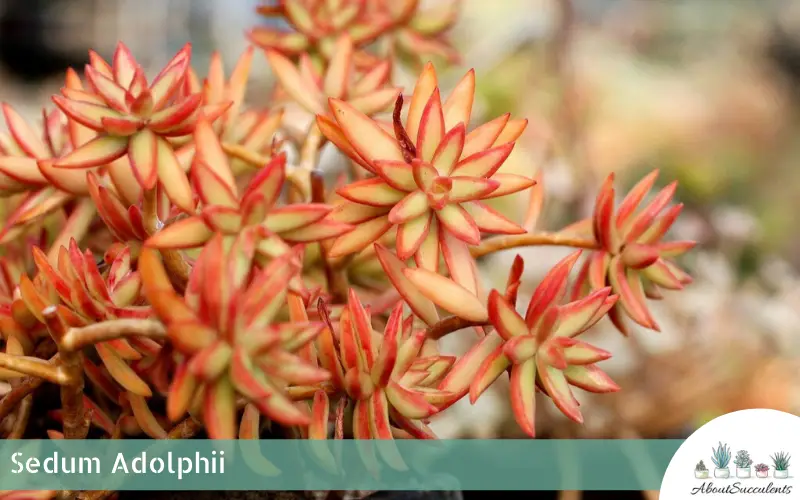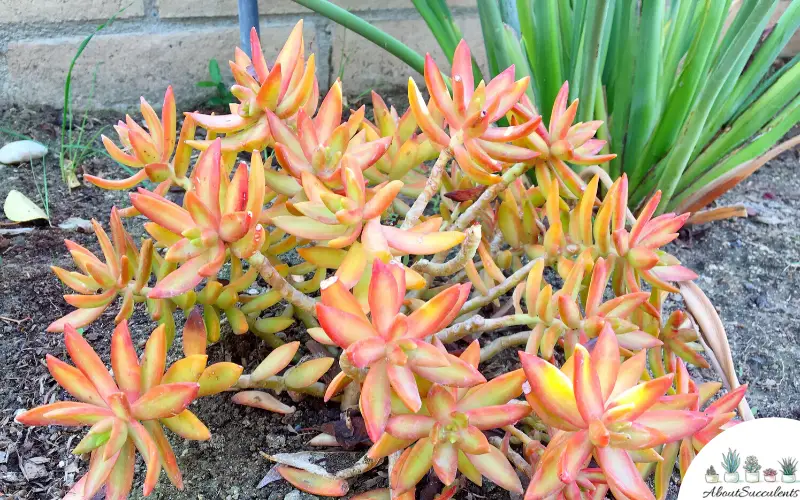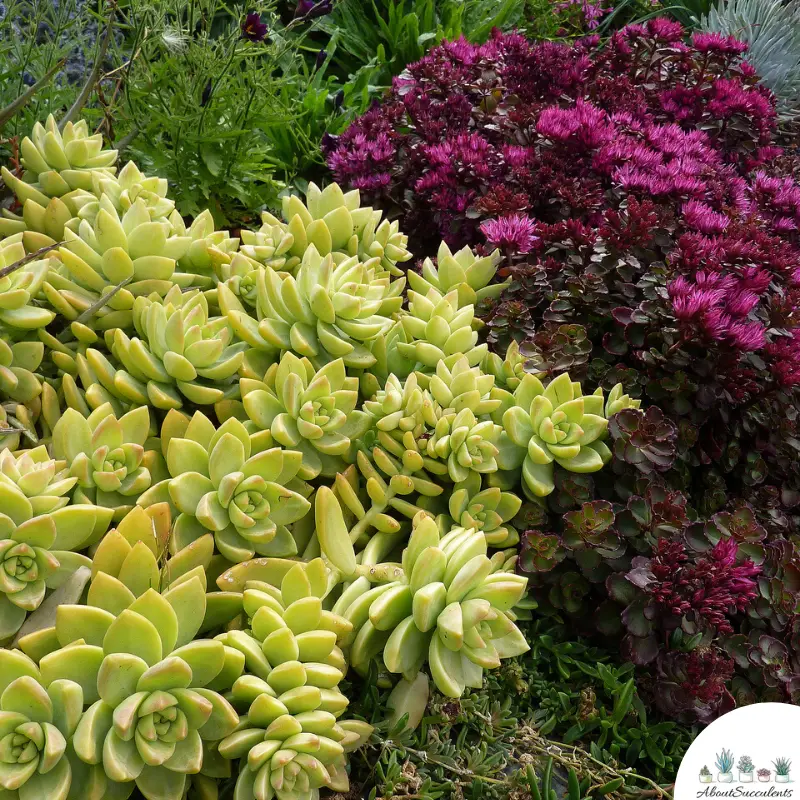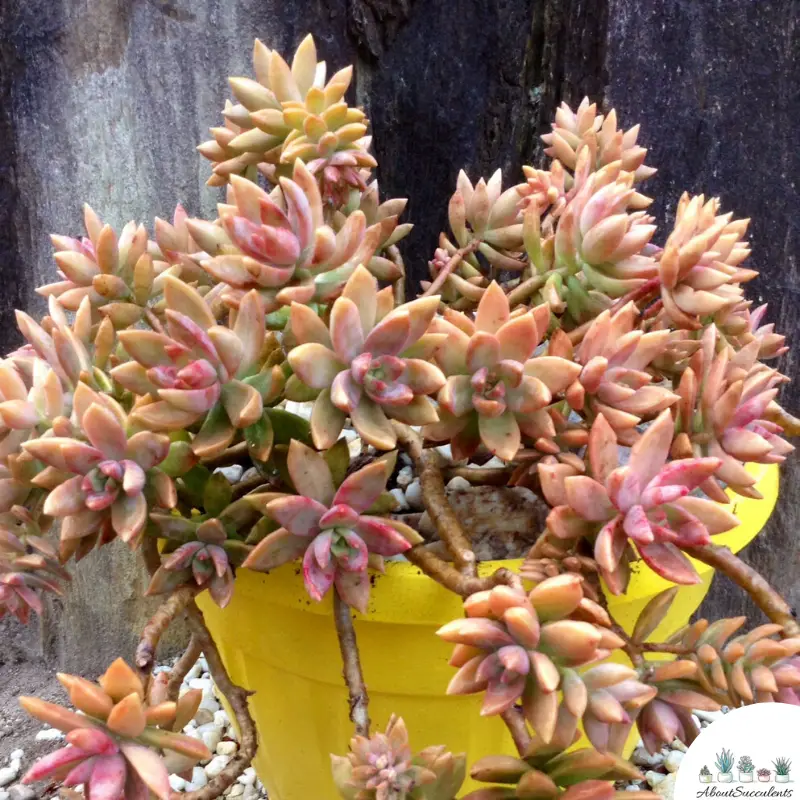
Sedum adolphii is a charming succulent with banana-shaped, dark-green leaves that form golden rosettes when the tips turn orange or a reddish-hue. In the springtime, Sedum adolphii produces white, star-shaped flowers.
Also called Golden Glow and Golden Sedum, this is a fast-growing and fast-spreading succulent. Golden Glow can grow up to 12-inches (30cm) in height and 24-inches (61cm) wide.
Golden Glow comes from the Crassulaceae family and is native to Mexico.
General Information:
Also known as: Golden Glow, Golden Sedum
Plant Family: Crassulaceae
Origin: Mexico
Height: 12-inches (30cm)
Exposure: Partial to full sunlight; 4 to 6 hours per day.
Water Needs: Water only when soil is dry to the touch, little watering during the winter months.
Soil Type: Cactus or sandy soil mixed with gravel at a 1:1 ratio
Soil pH: Slightly acidic (6.0 to 6.5 pH)
Tolerance: Drought
How to Grow and Care for Sedum Adolphii
Sedum adolphii is popularly used as ground cover for outdoor succulent gardens because of its ability to grow and spread fast.
Golden Glow can also grow indoors. Since this is not a cold-hardy plant and can barely survive -1.6 Celsius (29 Fahrenheit). If you live in a region where the temperature can fall below this level, it would be best to grow Sedum adolphii indoors.
1. Sunlight
Sedum adolphii can attain its bright orange and reddish color when it is regularly exposed to sunlight.
If grown outdoors as part of a succulent garden, make sure Golden Glow is in an area that gets 6 hours of morning sunlight. Avoid exposing this succulent to the scorching heat of the afternoon sun as its leaves can get sunburned.

If you are planning to grow Sedum adolphii indoors, place it near a window that gets a good amount of sunlight for 4 to 6 hours per day. The other option is to get a Grow Light to ensure Golden Glow gets the amount of light it needs to grow properly.
2. Watering
Sedum adolphii should only receive water when its soil is completely dry otherwise the roots could be exposed to the risk of rotting.
Golden Glow has the same watering needs of a typical succulent plant. You should expect to give it more water during the summer season when the soil dries out faster.
In the winter season, the soil tends to hold on to moisture longer. This means the Sedum adolphii succulent plant will not need as much water. Remember, it is better to under- water Golden Glow than to overwater it.
You can check the moisture level of the soil by using a hygrometer, You can also insert a stick approximately an inch below the topsoil. If the stick comes out dry, prepare to water Golden Glow.
3. Pot and Soil
If you want to grow Sedum adolphii in a pot, buy one that is made of clay and has not undergone the glazing process. Clay is well-regarded for its ability to allow excess moisture to evaporate along the sides of the pot. By using a clay pot for Golden Glow, you reduce the risk of overwatering.
For best-growing results, use well-draining soil for Sedum adolphii. You can use cactus or sandy soil and add gravel at a 1:1 ratio to improve the level of drainage. Waterlogged soil can lead to the roots being submerged in a moist environment for a long time.

It is also advisable to give Sedum adolphii fertilizer during the growing months of spring and summer. Make sure the fertilizer is mixed with water to reduce it to ¼ its original strength.
How to Propagate Sedum Adolphii
Sedum adolphii is popular with horticulturists because it is easy to propagate. There are 2 ways to propagate Golden Glow: Leaves and Cuttings.
Method 1 – Leaves
Step 1: Choose a firm and healthy leaf from the main plant.
Step 2: Perform a clean pull whereby no part of the leaf is left on the stem. A clean pull gives you a better chance of pulling off successful propagation.
Step 3: Place the leaf in a dry and shaded area for a few days to allow it to grow calluses.

Step 4: Place the callused leaf on well-draining soil and give it water whenever the soil has gone completely dry.
Method 2 – Cuttings
Step 1: Cut a part of the stem away from the Sedum cluster by using either a sterilized and sharpened knife or a pair of garden shears.
Step 2: Leave the cut in a dry and shaded area to allow it to harden properly and develop calluses.
Step 3: Once the cut has hardened enough, plant it in well-draining soil and water it whenever the soil is dry.
Frequently Asked Questions
Is Sedum Adolphii Toxic for Cats and Dogs?
Sedum adolphii does not appear in the list of plants that are toxic to cats and dogs that appear on the website of the American Society for the Prevention of Cruelty to Animals (ASPCA).
Why is my Sedum Adolphii Succulent Dying?
Overwatering is the most common cause of death of succulent plants including Sedum adolphii. Otherwise, Golden Glow is highly-resistant to diseases.
When Sedum adolphii receives too much water, its soil remains soil for a longer period. The soil becomes waterlogged and the roots become susceptible to rotting.
If the roots rot, an infection can develop which can spread throughout the plant within a short span of time.
A sign of root rot is the color of the leaves changing from dark-green to yellow or brown. When you see discoloration, remove the infected part right away with a sharpened and sterilized pair of garden shears.
From there, slowly remove the Golden Glow from its soil. Make sure to shake off the excess soil to help you find more rotting roots. Cut off the rotting roots and allow the plant to dry out completely.
Replant Sedum adolphii in fresh, well-draining soil.
Does Sedum Adolphii Produce Flowers?
Yes, Sedum adolphii produces small, white, and beautiful flowers in the springtime.
Last Updated on June 10, 2022 by Sofia Lara